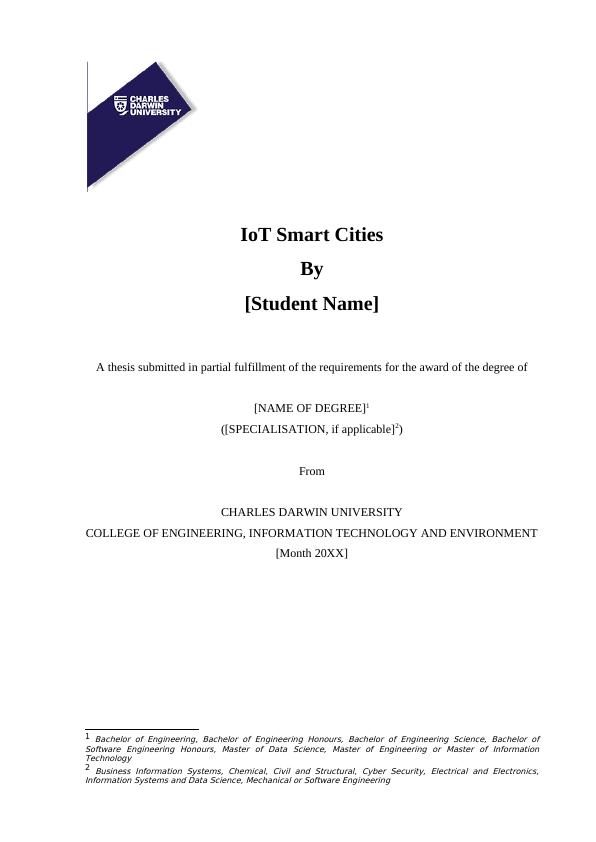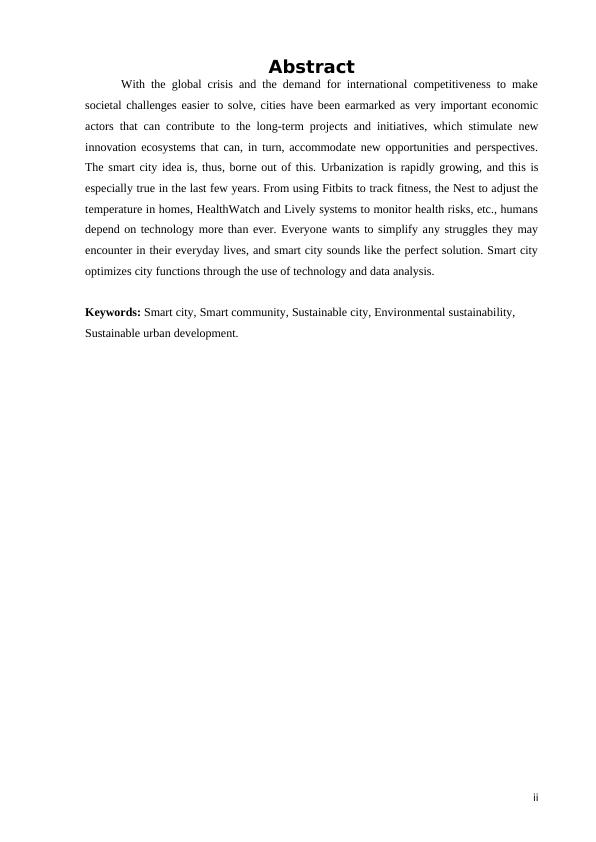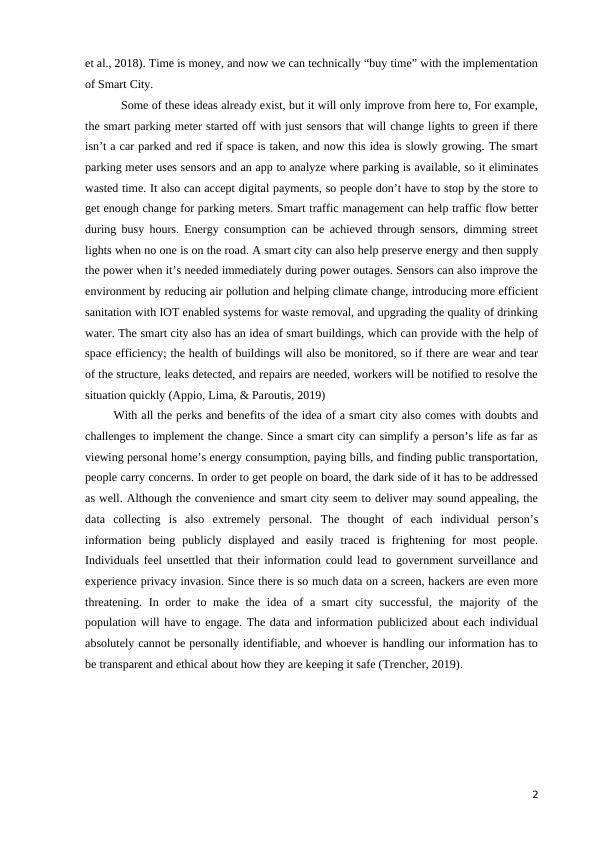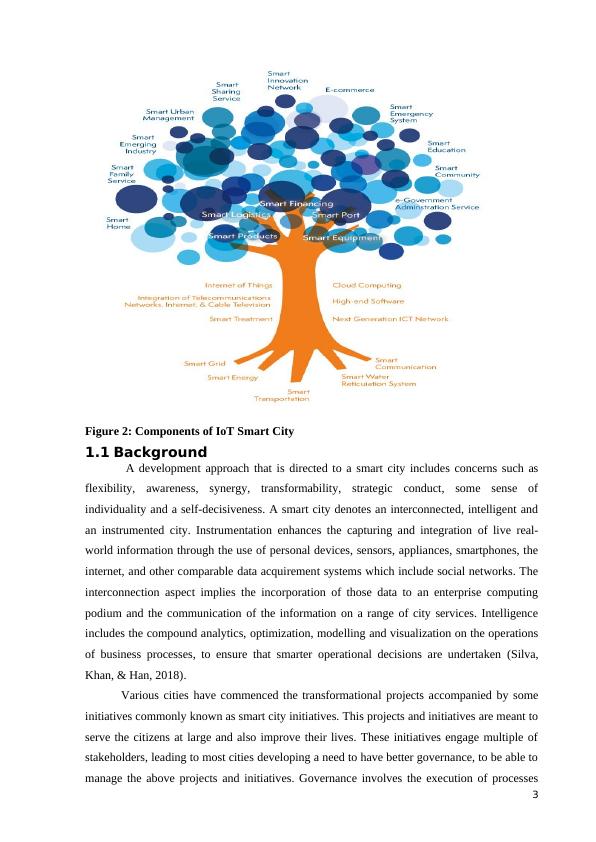IoT Smart Cities
Developing IoT innovation and foundation for Smart Cities, focusing on the impact and benefits of smart city connectivity and future technology advancements.
32 Pages11509 Words41 Views
Added on 2023-01-03
About This Document
This document explores the concept of IoT Smart Cities and discusses how technology influences efficiency in a smart city. It covers the advantages and challenges of implementing smart city initiatives, including the use of sensors, IoT devices, and cloud-based services. The document also addresses the impact of technology on urban governance and the potential for increased inequalities and digital divide. It provides insights into the role of technology in optimizing city functions and improving the quality of life for citizens.
IoT Smart Cities
Developing IoT innovation and foundation for Smart Cities, focusing on the impact and benefits of smart city connectivity and future technology advancements.
Added on 2023-01-03
ShareRelated Documents
IoT Smart Cities
By
[Student Name]
A thesis submitted in partial fulfillment of the requirements for the award of the degree of
[NAME OF DEGREE]1
([SPECIALISATION, if applicable]2)
From
CHARLES DARWIN UNIVERSITY
COLLEGE OF ENGINEERING, INFORMATION TECHNOLOGY AND ENVIRONMENT
[Month 20XX]
1
Bachelor of Engineering, Bachelor of Engineering Honours, Bachelor of Engineering Science, Bachelor of
Software Engineering Honours, Master of Data Science, Master of Engineering or Master of Information
Technology
2
Business Information Systems, Chemical, Civil and Structural, Cyber Security, Electrical and Electronics,
Information Systems and Data Science, Mechanical or Software Engineering
By
[Student Name]
A thesis submitted in partial fulfillment of the requirements for the award of the degree of
[NAME OF DEGREE]1
([SPECIALISATION, if applicable]2)
From
CHARLES DARWIN UNIVERSITY
COLLEGE OF ENGINEERING, INFORMATION TECHNOLOGY AND ENVIRONMENT
[Month 20XX]
1
Bachelor of Engineering, Bachelor of Engineering Honours, Bachelor of Engineering Science, Bachelor of
Software Engineering Honours, Master of Data Science, Master of Engineering or Master of Information
Technology
2
Business Information Systems, Chemical, Civil and Structural, Cyber Security, Electrical and Electronics,
Information Systems and Data Science, Mechanical or Software Engineering

Declaration
I hereby declare that the work herein, now submitted as [an interim report/a report/a thesis]
for the degree of [Name of Degree] ([Specialisation, if applicable]) at Charles Darwin
University, is the result of my own investigations, and all references to ideas and work of
other researchers have been specifically acknowledged. I hereby certify that the work
embodied in this [interim report/report/thesis] has not already been accepted in substance for
any degree, and is not being currently submitted in candidature for any other degree.
Signature: _________________________
Date: ______________________
i
I hereby declare that the work herein, now submitted as [an interim report/a report/a thesis]
for the degree of [Name of Degree] ([Specialisation, if applicable]) at Charles Darwin
University, is the result of my own investigations, and all references to ideas and work of
other researchers have been specifically acknowledged. I hereby certify that the work
embodied in this [interim report/report/thesis] has not already been accepted in substance for
any degree, and is not being currently submitted in candidature for any other degree.
Signature: _________________________
Date: ______________________
i

Abstract
With the global crisis and the demand for international competitiveness to make
societal challenges easier to solve, cities have been earmarked as very important economic
actors that can contribute to the long-term projects and initiatives, which stimulate new
innovation ecosystems that can, in turn, accommodate new opportunities and perspectives.
The smart city idea is, thus, borne out of this. Urbanization is rapidly growing, and this is
especially true in the last few years. From using Fitbits to track fitness, the Nest to adjust the
temperature in homes, HealthWatch and Lively systems to monitor health risks, etc., humans
depend on technology more than ever. Everyone wants to simplify any struggles they may
encounter in their everyday lives, and smart city sounds like the perfect solution. Smart city
optimizes city functions through the use of technology and data analysis.
Keywords: Smart city, Smart community, Sustainable city, Environmental sustainability,
Sustainable urban development.
ii
With the global crisis and the demand for international competitiveness to make
societal challenges easier to solve, cities have been earmarked as very important economic
actors that can contribute to the long-term projects and initiatives, which stimulate new
innovation ecosystems that can, in turn, accommodate new opportunities and perspectives.
The smart city idea is, thus, borne out of this. Urbanization is rapidly growing, and this is
especially true in the last few years. From using Fitbits to track fitness, the Nest to adjust the
temperature in homes, HealthWatch and Lively systems to monitor health risks, etc., humans
depend on technology more than ever. Everyone wants to simplify any struggles they may
encounter in their everyday lives, and smart city sounds like the perfect solution. Smart city
optimizes city functions through the use of technology and data analysis.
Keywords: Smart city, Smart community, Sustainable city, Environmental sustainability,
Sustainable urban development.
ii

Table of Contents
DECLARATION.......................................................................................................................I
ABSTRACT..............................................................................................................................II
LIST OF FIGURES................................................................................................................IV
1. INTRODUCTION.............................................................................................................1
1.1 BACKGROUND.................................................................................................................3
1.2 AIM OF RESEARCH / PROBLEM FORMULATION...........................................................4
2. LITERATURE REVIEW................................................................................................5
2.1 HOW TECHNOLOGY INFLUENCES EFFICIENCY IN A SMART CITY.............................5
2.2 SMART CITIES: WHAT ARE THE ADVANTAGES OF CONSTRUCTING THEM?............8
2.3 SMART CITY: A CASE OF DUBAI.................................................................................11
2.4 SMART CITY: A CASE OF DUBUQUE AND SONGDO IBD............................................13
3. CHAPTER COVERING APPROACH........................................................................16
4. ANALYSIS AND DISCUSSIONS.................................................................................16
4.1 HEALTHCARE...............................................................................................................16
4.2 PUBLIC TRANSPORT AND TRAFFIC.............................................................................17
4.3 ENVIRONMENT CONDITIONS.......................................................................................18
5. FUTURE WORK............................................................................................................18
6. CONCLUSIONS.............................................................................................................20
7. REFERENCES................................................................................................................22
Appendix A: Dubai Smart City.............................................................................................26
iii
DECLARATION.......................................................................................................................I
ABSTRACT..............................................................................................................................II
LIST OF FIGURES................................................................................................................IV
1. INTRODUCTION.............................................................................................................1
1.1 BACKGROUND.................................................................................................................3
1.2 AIM OF RESEARCH / PROBLEM FORMULATION...........................................................4
2. LITERATURE REVIEW................................................................................................5
2.1 HOW TECHNOLOGY INFLUENCES EFFICIENCY IN A SMART CITY.............................5
2.2 SMART CITIES: WHAT ARE THE ADVANTAGES OF CONSTRUCTING THEM?............8
2.3 SMART CITY: A CASE OF DUBAI.................................................................................11
2.4 SMART CITY: A CASE OF DUBUQUE AND SONGDO IBD............................................13
3. CHAPTER COVERING APPROACH........................................................................16
4. ANALYSIS AND DISCUSSIONS.................................................................................16
4.1 HEALTHCARE...............................................................................................................16
4.2 PUBLIC TRANSPORT AND TRAFFIC.............................................................................17
4.3 ENVIRONMENT CONDITIONS.......................................................................................18
5. FUTURE WORK............................................................................................................18
6. CONCLUSIONS.............................................................................................................20
7. REFERENCES................................................................................................................22
Appendix A: Dubai Smart City.............................................................................................26
iii

List of Figures
Figure 1: Smart City....................................................................................................................1
Figure 2: Components of IoT Smart City...................................................................................3
Figure 3: IEEE Standards for Smart City...................................................................................5
Figure 4: Smart City Components..............................................................................................7
Figure 5: Advantages of Smart City...........................................................................................9
Figure 6: The rise of Smart Cities.............................................................................................12
Figure 7: Water technology in Smart City................................................................................14
Figure 8: Future smart solutions...............................................................................................19
iv
Figure 1: Smart City....................................................................................................................1
Figure 2: Components of IoT Smart City...................................................................................3
Figure 3: IEEE Standards for Smart City...................................................................................5
Figure 4: Smart City Components..............................................................................................7
Figure 5: Advantages of Smart City...........................................................................................9
Figure 6: The rise of Smart Cities.............................................................................................12
Figure 7: Water technology in Smart City................................................................................14
Figure 8: Future smart solutions...............................................................................................19
iv

1. Introduction
A smart city refers to a well-performing city in terms of its people; its economy,
governance, it's surrounding, its forms of mobility and living. It is thus; built on a smart
amalgamation of endowments, alert citizens, independent, and activities of self-decisive. It is
a city that carries out monitoring and integration of all conditions relating to its critical
infrastructures, bridges, roads, airports, communications, and it also deals with how it can
fully optimize its resources, plan on its preventive maintenance actions, monitor its security
features while at the same time, optimize services to its citizens (Moustaka et al., 2019). A
smart city generally, strives towards making itself smarter in terms of efficiency,
sustainability, ensuring equity and enhancing liveability. Smart cities rely, among others, on
the compilation of brilliant computing technologies that are applied to the significant
infrastructure elements and services. Smart computing is all about a new generation of
amalgamated hardware, software combined with network technologies that offer IT systems
with the real-time consciousness of the real world and complex analytics that assist citizens in
making smart decisions, which would help them optimize their business processes
Figure 1: Smart City
In the past few years, technology has really boomed. Who really leaves to go
anywhere without their phones now? Our whole lives are on that little screen. People are
relying on new technology to make lives easier, and this is exactly where the smart city comes
in. A smart city is generally just making the most out of our technology to simplify our
everyday lives by the collection and analyzing of data. The overall goal and ideal result of
implementing Smart city are to help improve the quality of life, simplify it, maximize the use
of the technology we’ve created, and drive economic growth while doing all that (Mohamed
1
A smart city refers to a well-performing city in terms of its people; its economy,
governance, it's surrounding, its forms of mobility and living. It is thus; built on a smart
amalgamation of endowments, alert citizens, independent, and activities of self-decisive. It is
a city that carries out monitoring and integration of all conditions relating to its critical
infrastructures, bridges, roads, airports, communications, and it also deals with how it can
fully optimize its resources, plan on its preventive maintenance actions, monitor its security
features while at the same time, optimize services to its citizens (Moustaka et al., 2019). A
smart city generally, strives towards making itself smarter in terms of efficiency,
sustainability, ensuring equity and enhancing liveability. Smart cities rely, among others, on
the compilation of brilliant computing technologies that are applied to the significant
infrastructure elements and services. Smart computing is all about a new generation of
amalgamated hardware, software combined with network technologies that offer IT systems
with the real-time consciousness of the real world and complex analytics that assist citizens in
making smart decisions, which would help them optimize their business processes
Figure 1: Smart City
In the past few years, technology has really boomed. Who really leaves to go
anywhere without their phones now? Our whole lives are on that little screen. People are
relying on new technology to make lives easier, and this is exactly where the smart city comes
in. A smart city is generally just making the most out of our technology to simplify our
everyday lives by the collection and analyzing of data. The overall goal and ideal result of
implementing Smart city are to help improve the quality of life, simplify it, maximize the use
of the technology we’ve created, and drive economic growth while doing all that (Mohamed
1

et al., 2018). Time is money, and now we can technically “buy time” with the implementation
of Smart City.
Some of these ideas already exist, but it will only improve from here to, For example,
the smart parking meter started off with just sensors that will change lights to green if there
isn’t a car parked and red if space is taken, and now this idea is slowly growing. The smart
parking meter uses sensors and an app to analyze where parking is available, so it eliminates
wasted time. It also can accept digital payments, so people don’t have to stop by the store to
get enough change for parking meters. Smart traffic management can help traffic flow better
during busy hours. Energy consumption can be achieved through sensors, dimming street
lights when no one is on the road. A smart city can also help preserve energy and then supply
the power when it’s needed immediately during power outages. Sensors can also improve the
environment by reducing air pollution and helping climate change, introducing more efficient
sanitation with IOT enabled systems for waste removal, and upgrading the quality of drinking
water. The smart city also has an idea of smart buildings, which can provide with the help of
space efficiency; the health of buildings will also be monitored, so if there are wear and tear
of the structure, leaks detected, and repairs are needed, workers will be notified to resolve the
situation quickly (Appio, Lima, & Paroutis, 2019)
With all the perks and benefits of the idea of a smart city also comes with doubts and
challenges to implement the change. Since a smart city can simplify a person’s life as far as
viewing personal home’s energy consumption, paying bills, and finding public transportation,
people carry concerns. In order to get people on board, the dark side of it has to be addressed
as well. Although the convenience and smart city seem to deliver may sound appealing, the
data collecting is also extremely personal. The thought of each individual person’s
information being publicly displayed and easily traced is frightening for most people.
Individuals feel unsettled that their information could lead to government surveillance and
experience privacy invasion. Since there is so much data on a screen, hackers are even more
threatening. In order to make the idea of a smart city successful, the majority of the
population will have to engage. The data and information publicized about each individual
absolutely cannot be personally identifiable, and whoever is handling our information has to
be transparent and ethical about how they are keeping it safe (Trencher, 2019).
2
of Smart City.
Some of these ideas already exist, but it will only improve from here to, For example,
the smart parking meter started off with just sensors that will change lights to green if there
isn’t a car parked and red if space is taken, and now this idea is slowly growing. The smart
parking meter uses sensors and an app to analyze where parking is available, so it eliminates
wasted time. It also can accept digital payments, so people don’t have to stop by the store to
get enough change for parking meters. Smart traffic management can help traffic flow better
during busy hours. Energy consumption can be achieved through sensors, dimming street
lights when no one is on the road. A smart city can also help preserve energy and then supply
the power when it’s needed immediately during power outages. Sensors can also improve the
environment by reducing air pollution and helping climate change, introducing more efficient
sanitation with IOT enabled systems for waste removal, and upgrading the quality of drinking
water. The smart city also has an idea of smart buildings, which can provide with the help of
space efficiency; the health of buildings will also be monitored, so if there are wear and tear
of the structure, leaks detected, and repairs are needed, workers will be notified to resolve the
situation quickly (Appio, Lima, & Paroutis, 2019)
With all the perks and benefits of the idea of a smart city also comes with doubts and
challenges to implement the change. Since a smart city can simplify a person’s life as far as
viewing personal home’s energy consumption, paying bills, and finding public transportation,
people carry concerns. In order to get people on board, the dark side of it has to be addressed
as well. Although the convenience and smart city seem to deliver may sound appealing, the
data collecting is also extremely personal. The thought of each individual person’s
information being publicly displayed and easily traced is frightening for most people.
Individuals feel unsettled that their information could lead to government surveillance and
experience privacy invasion. Since there is so much data on a screen, hackers are even more
threatening. In order to make the idea of a smart city successful, the majority of the
population will have to engage. The data and information publicized about each individual
absolutely cannot be personally identifiable, and whoever is handling our information has to
be transparent and ethical about how they are keeping it safe (Trencher, 2019).
2

Figure 2: Components of IoT Smart City
1.1 Background
A development approach that is directed to a smart city includes concerns such as
flexibility, awareness, synergy, transformability, strategic conduct, some sense of
individuality and a self-decisiveness. A smart city denotes an interconnected, intelligent and
an instrumented city. Instrumentation enhances the capturing and integration of live real-
world information through the use of personal devices, sensors, appliances, smartphones, the
internet, and other comparable data acquirement systems which include social networks. The
interconnection aspect implies the incorporation of those data to an enterprise computing
podium and the communication of the information on a range of city services. Intelligence
includes the compound analytics, optimization, modelling and visualization on the operations
of business processes, to ensure that smarter operational decisions are undertaken (Silva,
Khan, & Han, 2018).
Various cities have commenced the transformational projects accompanied by some
initiatives commonly known as smart city initiatives. This projects and initiatives are meant to
serve the citizens at large and also improve their lives. These initiatives engage multiple of
stakeholders, leading to most cities developing a need to have better governance, to be able to
manage the above projects and initiatives. Governance involves the execution of processes
3
1.1 Background
A development approach that is directed to a smart city includes concerns such as
flexibility, awareness, synergy, transformability, strategic conduct, some sense of
individuality and a self-decisiveness. A smart city denotes an interconnected, intelligent and
an instrumented city. Instrumentation enhances the capturing and integration of live real-
world information through the use of personal devices, sensors, appliances, smartphones, the
internet, and other comparable data acquirement systems which include social networks. The
interconnection aspect implies the incorporation of those data to an enterprise computing
podium and the communication of the information on a range of city services. Intelligence
includes the compound analytics, optimization, modelling and visualization on the operations
of business processes, to ensure that smarter operational decisions are undertaken (Silva,
Khan, & Han, 2018).
Various cities have commenced the transformational projects accompanied by some
initiatives commonly known as smart city initiatives. This projects and initiatives are meant to
serve the citizens at large and also improve their lives. These initiatives engage multiple of
stakeholders, leading to most cities developing a need to have better governance, to be able to
manage the above projects and initiatives. Governance involves the execution of processes
3

End of preview
Want to access all the pages? Upload your documents or become a member.
Related Documents
Bamboo-Rice Husk Compositelg...
|52
|5327
|46
